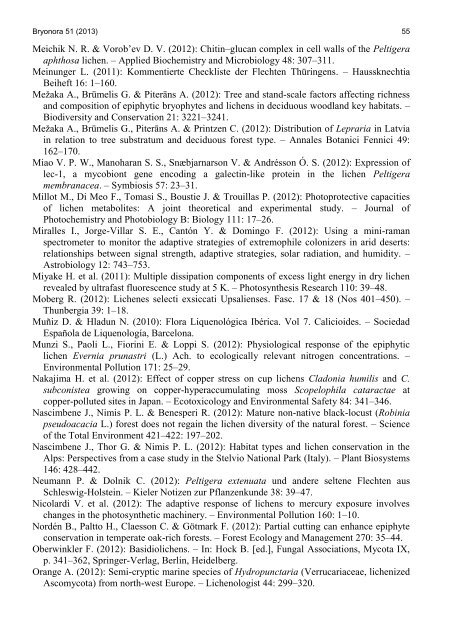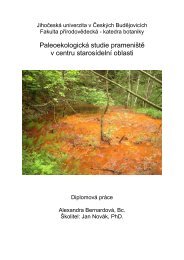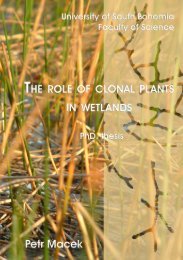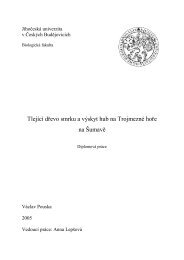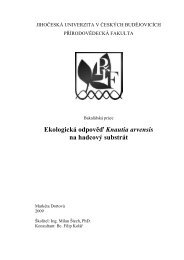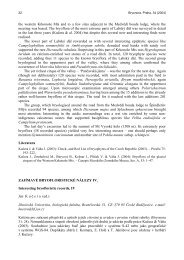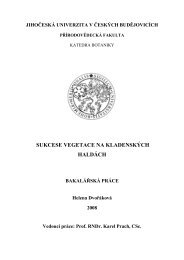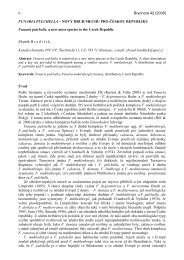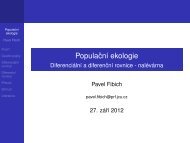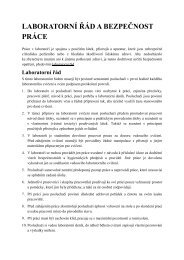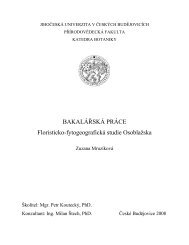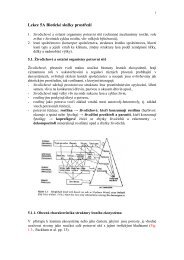NOVÁ LICHENOLOGICKÁ LITERATURA XXI. New lichenological ...
NOVÁ LICHENOLOGICKÁ LITERATURA XXI. New lichenological ...
NOVÁ LICHENOLOGICKÁ LITERATURA XXI. New lichenological ...
Create successful ePaper yourself
Turn your PDF publications into a flip-book with our unique Google optimized e-Paper software.
Bryonora 51 (2013) 55<br />
Meichik N. R. & Vorob’ev D. V. (2012): Chitin–glucan complex in cell walls of the Peltigera<br />
aphthosa lichen. – Applied Biochemistry and Microbiology 48: 307–311.<br />
Meinunger L. (2011): Kommentierte Checkliste der Flechten Thüringens. – Haussknechtia<br />
Beiheft 16: 1–160.<br />
Mežaka A., Brūmelis G. & Piterāns A. (2012): Tree and stand-scale factors affecting richness<br />
and composition of epiphytic bryophytes and lichens in deciduous woodland key habitats. –<br />
Biodiversity and Conservation 21: 3221–3241.<br />
Mežaka A., Brūmelis G., Piterāns A. & Printzen C. (2012): Distribution of Lepraria in Latvia<br />
in relation to tree substratum and deciduous forest type. – Annales Botanici Fennici 49:<br />
162–170.<br />
Miao V. P. W., Manoharan S. S., Snæbjarnarson V. & Andrésson Ó. S. (2012): Expression of<br />
lec-1, a mycobiont gene encoding a galectin-like protein in the lichen Peltigera<br />
membranacea. – Symbiosis 57: 23–31.<br />
Millot M., Di Meo F., Tomasi S., Boustie J. & Trouillas P. (2012): Photoprotective capacities<br />
of lichen metabolites: A joint theoretical and experimental study. – Journal of<br />
Photochemistry and Photobiology B: Biology 111: 17–26.<br />
Miralles I., Jorge-Villar S. E., Cantón Y. & Domingo F. (2012): Using a mini-raman<br />
spectrometer to monitor the adaptive strategies of extremophile colonizers in arid deserts:<br />
relationships between signal strength, adaptive strategies, solar radiation, and humidity. –<br />
Astrobiology 12: 743–753.<br />
Miyake H. et al. (2011): Multiple dissipation components of excess light energy in dry lichen<br />
revealed by ultrafast fluorescence study at 5 K. – Photosynthesis Research 110: 39–48.<br />
Moberg R. (2012): Lichenes selecti exsiccati Upsalienses. Fasc. 17 & 18 (Nos 401–450). –<br />
Thunbergia 39: 1–18.<br />
Muñiz D. & Hladun N. (2010): Flora Liquenológica Ibérica. Vol 7. Calicioides. – Sociedad<br />
Española de Liquenología, Barcelona.<br />
Munzi S., Paoli L., Fiorini E. & Loppi S. (2012): Physiological response of the epiphytic<br />
lichen Evernia prunastri (L.) Ach. to ecologically relevant nitrogen concentrations. –<br />
Environmental Pollution 171: 25–29.<br />
Nakajima H. et al. (2012): Effect of copper stress on cup lichens Cladonia humilis and C.<br />
subconistea growing on copper-hyperaccumulating moss Scopelophila cataractae at<br />
copper-polluted sites in Japan. – Ecotoxicology and Environmental Safety 84: 341–346.<br />
Nascimbene J., Nimis P. L. & Benesperi R. (2012): Mature non-native black-locust (Robinia<br />
pseudoacacia L.) forest does not regain the lichen diversity of the natural forest. – Science<br />
of the Total Environment 421–422: 197–202.<br />
Nascimbene J., Thor G. & Nimis P. L. (2012): Habitat types and lichen conservation in the<br />
Alps: Perspectives from a case study in the Stelvio National Park (Italy). – Plant Biosystems<br />
146: 428–442.<br />
Neumann P. & Dolnik C. (2012): Peltigera extenuata und andere seltene Flechten aus<br />
Schleswig-Holstein. – Kieler Notizen zur Pflanzenkunde 38: 39–47.<br />
Nicolardi V. et al. (2012): The adaptive response of lichens to mercury exposure involves<br />
changes in the photosynthetic machinery. – Environmental Pollution 160: 1–10.<br />
Nordén B., Paltto H., Claesson C. & Götmark F. (2012): Partial cutting can enhance epiphyte<br />
conservation in temperate oak-rich forests. – Forest Ecology and Management 270: 35–44.<br />
Oberwinkler F. (2012): Basidiolichens. – In: Hock B. [ed.], Fungal Associations, Mycota IX,<br />
p. 341–362, Springer-Verlag, Berlin, Heidelberg.<br />
Orange A. (2012): Semi-cryptic marine species of Hydropunctaria (Verrucariaceae, lichenized<br />
Ascomycota) from north-west Europe. – Lichenologist 44: 299–320.


